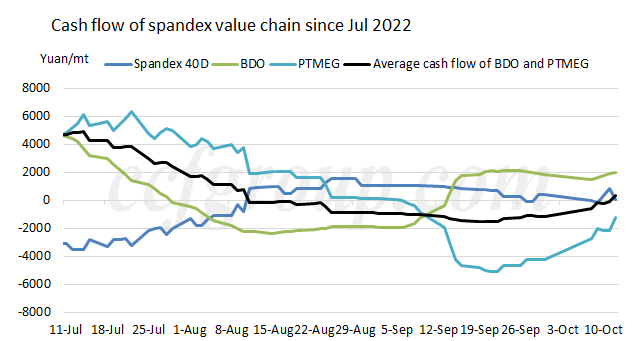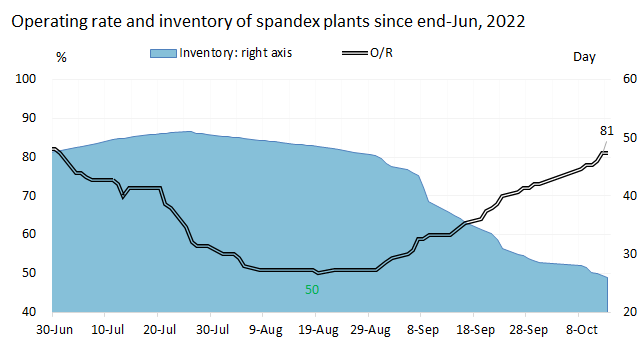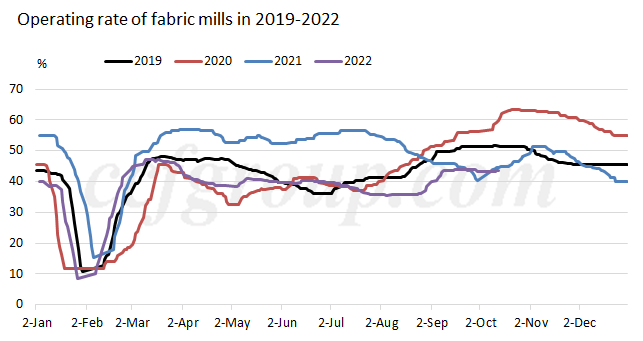Will spandex price keep advancing after spiked by 10%?
Sales of spandex improved in end-Q3 and early-Q4, 2022. Spandex price surged after the National Day holiday, with increment at around 10%.
| Price change of spandex and feedstock (Unit: yuan/mt) | ||||||
| Date | Feedstock | Spandex | ||||
| PTMEG | MMDI | Major feedstock cost | 20D | 30D | 40D | |
| 2022/9/1 | 17,500 | 18,100 | 16,908 | 36,000 | 33,000 | 30,500 |
| 2022/10/13 | 22,000 | 21,000 | 20,940 | 39,500 | 36,500 | 34,000 |
| Change | 4,500 | 2,900 | 4,032 | 3,500 | 3,500 | 3,500 |
| Change % | 25.7% | 16.0% | 23.8% | 9.7% | 10.6% | 11.5% |
Firstly, as feedstock price soared more, the spot cash flow of spandex continued shrinking. Spandex plants were eager to follow the uptrend on feedstock market and strongly insisted on raising price after holiday. Price of PTMEG rose more in Oct, with offers mainly required at 23,000yuan/mt, even higher at 24,000-25,000yuan/mt, negotiable in actual trading. Increasing price of PTMEG was mainly due to the following two reasons: on one hand, demand from downstream spandex plants grew after the operating rate of spandex companies greatly advanced; on the other hand, it was stimulated by the cost. BDO price climbed up in Sep while the delivery issue in some regions remains amid the spread of pandemic. In addition, price of MMDI also apparently rose. Wanhua Chemical's nomination of MMDI for Oct rose by 2,000yuan/mt to 23,000yuan/mt and the price in East China also obviously increased.

BDO and PTMEG markets were disrupted by the spread of pandemic in Northwest China, ending up with increasing price. Driven by rising price, some downstream buyers continued replenishing spandex after the National Day holiday. BDO plants suffered great losses and ran at low capacity in Q3 2022. The spread of pandemic impacted their delivery. However, PBT fiber and spandex, the downstream field of BDO, were during traditional peak season in Sep and Oct. As price of spandex value chain was expected to touch periodical bottom, buyers increased procuring spandex, with the inventory of spandex up to 10-30 days now from 1-7 days in early-Q3.
The inventory of spandex plants has decreased by near one month compared with early-Jul. More spandex varieties became tight. Spandex price obviously rose after the National Day holiday with cost pressure and tight supply. The production of some spandex varieties needed to queue in some plants. Therefore, spandex plants were active in ramping up run rate, while some companies met resistance in raising run rate when feedstock supply was limited. By Oct 13, the operating rate of spandex plants ascended to 81%, up by above 3 percentage points compared with Aug. The average operating rate of big spandex companies with above 70kt/year of capacity was at 85%, that of companies with 30-40kt/year of capacity was near 75% and that of enterprises with 20kt/year of capacity was below 40%.

However, demand for spandex from fabric mills was moderate. The operating rate of fabric mills apparently rose in Sep and Oct compared with the beginning of Q2. The production of thick fabrics slightly grew after the National Day holiday. Currently, the run rate of circular knitting plants in Zhejiang, Jiangsu and Foshan of Guangdong, and lace knitting mills in Fujian was at 30-45%, that of plants in Chaozhou and Shantou of Guangdong and Quanzhou of Fujian was above 50% and that of covered yarn mills, warp knitting plants, braid mills and diaper producers was at 50-80% or above. The production of thick fabrics like dralon fabric and fabrics for braid was relatively better. However, single-faced circular knitting plants and covered yarn mills witnessed inadequate orders and high stocks dampened the increase of run rate. The operating rate of downstream fabric mills may hold stable until end-Oct and start falling later.

Remark: above run rate is the average run rate of conventional covered yarn plants in Zhejiang, circular knitting plants in Guangdong, Zhejiang and Jiangsu, warp knitting plants in Guangdong and lace mills in Fujian.
In general, spandex plants have seen apparently falling inventory in Sep and current stocks can be described as normal-to-low. Price of MMDI and PTMEG obviously advances and the delivery of raw materials is impacted by the spread of pandemic in Xinjiang and Inner Mongolia. Spandex plants fail to resume operation rapidly. Supply of spandex may keep tight in short run. Demand for spandex is strong. The spandex inventory of some downstream plants can guarantee production near end-Oct. As feedstock market witnesses tight supply amid the pandemic and feedstock price is rising, price of spandex is likely to keep rising in short run. However, after the spread of pandemic eases, the delivery of feedstock becomes normal and the textile peak-season ends, while operating rate of spandex plants increases and supply tightness mitigates, spandex industry may need to find a balance between supply/demand and the cost again.
- Top keywords
- Cotton Price
- Cotton Futures Price
- Cotton Futures
- CZCE
- PTA Futures Price
- Chemical Fiber
- Polyester Prices
- Wool price
- PTA Futures
- Shengze Silk
- China
- Yarn Price
- price
- China Textile City
- Fibre Price
- Benzene Price
- Cotton
- Index
- Cotton Index
- PTA
- fabric price
- NYMEX
- Top 10
- textile industry
- Spot Cotton
- Cotton Yarn
- Polyester Price
- Futures
- PTA Price
- cotton yarn price

